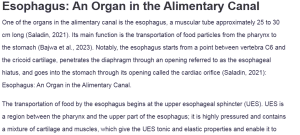Esophagus: An Organ in the Alimentary Canal
One of the organs in the alimentary canal is the esophagus, a muscular tube approximately 25 to 30 cm long (Saladin, 2021). Its main function is the transportation of food particles from the pharynx to the stomach (Bajwa et al., 2023). Notably, the esophagus starts from a point between vertebra C6 and the cricoid cartilage, penetrates the diaphragm through an opening referred to as the esophageal hiatus, and goes into the stomach through its opening called the cardiac orifice (Saladin, 2021): Esophagus: An Organ in the Alimentary Canal.
The transportation of food by the esophagus begins at the upper esophageal sphincter (UES). UES is a region between the pharynx and the upper part of the esophagus; it is highly pressured and contains a mixture of cartilage and muscles, which give the UES tonic and elastic properties and enable it to open wide in response to stimuli (Bajwa et al., 2023). Also, the UES prevents the regurgitation of food into the airways and large amounts of air from getting into the gastrointestinal tract (Bajwa et al., 2023).
From the UES, food moves through the esophageal body to the lower esophageal sphincter (LES), from where it can then move into the stomach. The LES has a high-pressured zone and contains smooth muscles that help keep it tightly closed. Essentially, it prevents the regurgitation of stomach contents into the esophagus, thus protecting the esophagus from the acidity and digestive properties of gastric juice (Bajwa et al., 2023; Saladin, 2021).
In addition, the esophageal wall constitutes tissue layers for proper functioning. The mucosa is the innermost layer with a nonkeratinized stratified squamous epithelial layer. Second, the submucosa has esophageal glands that secrete mucus for lubrication.
The mucosa and submucosa fold into longitudinal ridges once the esophagus is empty, making the lumen appear star-shaped (Saladin, 2021). Third, the muscularis externa comprises both skeletal muscle and smooth muscle. The outermost layer is a connective tissue adventitia that links the esophagus to other structures.
References
Bajwa, S. A., Toro, F., & Kasi, A. (2023, May 1). Physiology, esophagus. StatPearls – NCBI Bookshelf. https://www.ncbi.nlm.nih.gov/books/NBK519011/
Saladin, K. (2021). Anatomy and physiology: The unity of form and function (9th ed.). McGraw-Hill Education.
ORDER A PLAGIARISM-FREE PAPER HERE
We’ll write everything from scratch
Question 
Initial Post Instructions
The digestive system is composed of two parts: the alimentary canal and the accessory digestive structures. These two parts of the system work together to break down food into absorbable units and eliminate the non-digested material as feces. Let’s begin by identifying each of the organs in the alimentary canal and the accessory digestive structures.
Choose one organ/structure and post details about it to begin the discussion. Choose a different organ for each of your follow-up posts to ensure everyone has an opportunity to contribute.

Esophagus: An Organ in the Alimentary Canal
Writing Requirements
- Minimum of 2 posts (1 initial & 1 follow-up)
- Minimum of 2 sources cited (assigned readings/online lessons and an outside source)
- APA format for in-text citations and list of references
